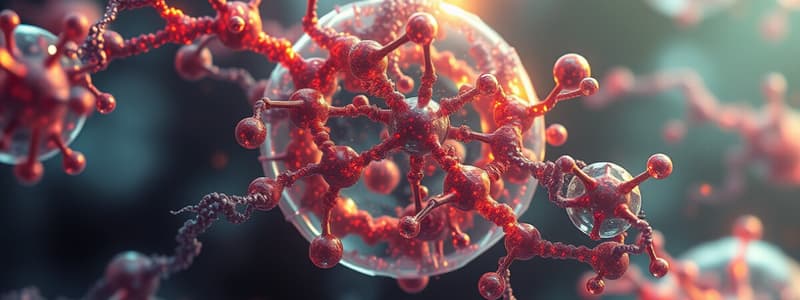Podcast
Questions and Answers
What defines biochemistry?
What defines biochemistry?
- The study of chemical processes in lifeless matter.
- The study of chemical processes within living organisms. (correct)
- The study of physical structures of cells.
- The study of mechanical systems in living things.
Which of the following is NOT a part of a cell?
Which of the following is NOT a part of a cell?
- Cytoplasm
- Eukaryotic nucleus
- Mitochondrial membrane (correct)
- Plasma membrane
Which statement about prokaryotic cells is accurate?
Which statement about prokaryotic cells is accurate?
- They are predominantly multicellular organisms.
- They lack a nucleus and have a nucleoid. (correct)
- Their genetic material is housed in a nucleus.
- They contain membrane-bound organelles.
Which molecules are classified as the four basic classes found in cells?
Which molecules are classified as the four basic classes found in cells?
Which organism can be classified as a eukaryote?
Which organism can be classified as a eukaryote?
What is the primary function of the capsule in prokaryotic cells?
What is the primary function of the capsule in prokaryotic cells?
Which structure in prokaryotic cells is responsible for protein synthesis?
Which structure in prokaryotic cells is responsible for protein synthesis?
How does the cell wall in prokaryotic cells contribute to cell function?
How does the cell wall in prokaryotic cells contribute to cell function?
In eukaryotic cells, what is the function of the membrane-bound nucleus?
In eukaryotic cells, what is the function of the membrane-bound nucleus?
What role do pili play in prokaryotic cells?
What role do pili play in prokaryotic cells?
What is the primary function of ribosomes in eukaryotic cells?
What is the primary function of ribosomes in eukaryotic cells?
Which component of the eukaryotic cell controls the passage of materials between the nucleus and cytoplasm?
Which component of the eukaryotic cell controls the passage of materials between the nucleus and cytoplasm?
What do peroxisomes primarily accomplish in a eukaryotic cell?
What do peroxisomes primarily accomplish in a eukaryotic cell?
What is the condensed region within the nucleus where ribosomes are formed called?
What is the condensed region within the nucleus where ribosomes are formed called?
Which structure is responsible for energy production in the form of ATP in eukaryotic cells?
Which structure is responsible for energy production in the form of ATP in eukaryotic cells?
What is the primary function of lysosomes in eukaryotic cells?
What is the primary function of lysosomes in eukaryotic cells?
Which cellular organelle is responsible for sorting, tagging, and distributing proteins and lipids?
Which cellular organelle is responsible for sorting, tagging, and distributing proteins and lipids?
What do vacuoles in plant cells contain that aids in the breakdown of macromolecules?
What do vacuoles in plant cells contain that aids in the breakdown of macromolecules?
What distinguishes the Rough Endoplasmic Reticulum from the Smooth Endoplasmic Reticulum?
What distinguishes the Rough Endoplasmic Reticulum from the Smooth Endoplasmic Reticulum?
Which of the following structures serves as the microtubule-organizing center in eukaryotic cells?
Which of the following structures serves as the microtubule-organizing center in eukaryotic cells?
Flashcards are hidden until you start studying
Study Notes
Biochemistry Overview
- Study of chemical processes in living organisms.
- Four fundamental classes of small molecules: amino acids, carbohydrates, lipids, and nucleic acids.
- RNA has the unique ability to catalyze its own processing.
Cell Structure and Function
- Common components of all cells include:
- Plasma membrane: outer covering defining the cell's boundary.
- Cytoplasm: jelly-like substance containing cellular components.
- DNA: genetic material stored within the cell.
- Ribosomes: sites for protein synthesis.
Prokaryotic Cells
- Simple, single-celled organisms lacking a nucleus and membrane-bound organelles.
- DNA is located in the nucleoid, a central area in the cell.
Prokaryotic Cell Components
- Capsule: protective outer layer in bacterial cells.
- Cell wall: composed of peptidoglycan, provides shape and prevents dehydration.
- Cytoplasm: medium for chemical reactions, contains organelles.
- Ribosomes: responsible for protein synthesis.
- Nucleoid: location of genetic material.
- Flagellum: aids in movement.
- Pili: facilitates genetic exchange during conjugation.
- Fimbrae: helps cells attach to host cells.
Eukaryotic Cells
- Characterized by a membrane-bound nucleus and organelles.
- Contains multiple rod-shaped chromosomes.
Eukaryotic Cell Components
- Nucleus: contains DNA and directs the synthesis of ribosomes and proteins.
- Nucleolus: where ribosomes are formed.
- Nuclear Envelope: membrane surrounding the nucleus, with pores regulating transport.
- Chromatin: complex of DNA and protein packaging.
Additional Eukaryotic Organelles
- Ribosomes: sites of protein synthesis.
- Mitochondria: generate ATP for energy.
- Peroxisomes: metabolize waste and detoxify substances.
- Vesicles and Vacuoles: involved in storage and transport; vacuoles in plants often contain enzymes for breaking down macromolecules.
- Centrosome: organizes microtubules, originating point for all microtubules.
- Lysosome: digests cellular waste and food materials.
- Golgi Apparatus: modifies, sorts, and distributes proteins and lipids.
- Smooth Endoplasmic Reticulum: synthesizes carbohydrates, lipids, and steroid hormones.
- Rough Endoplasmic Reticulum: produces phospholipids and proteins, associated with ribosomes for protein synthesis.
Studying That Suits You
Use AI to generate personalized quizzes and flashcards to suit your learning preferences.




